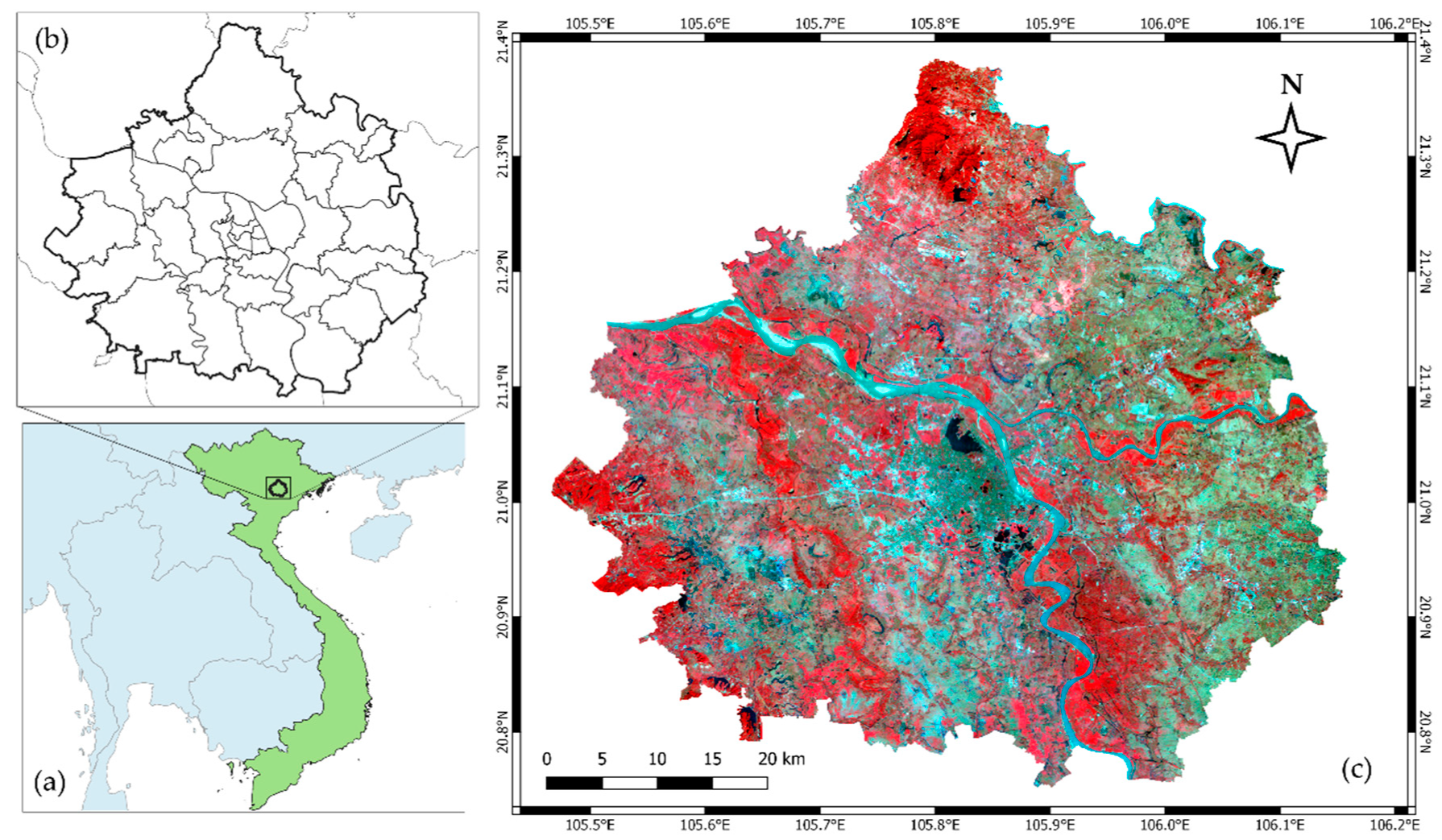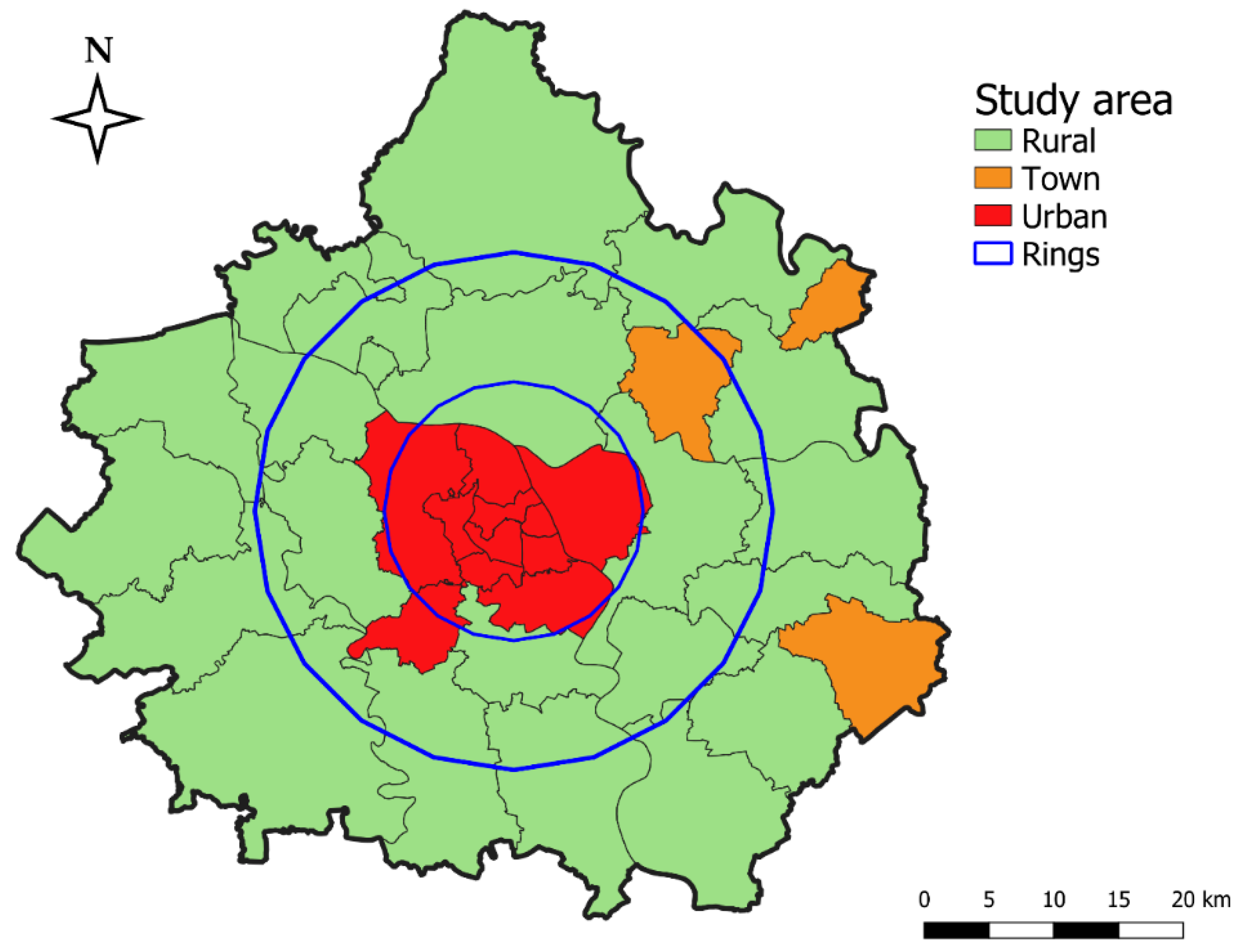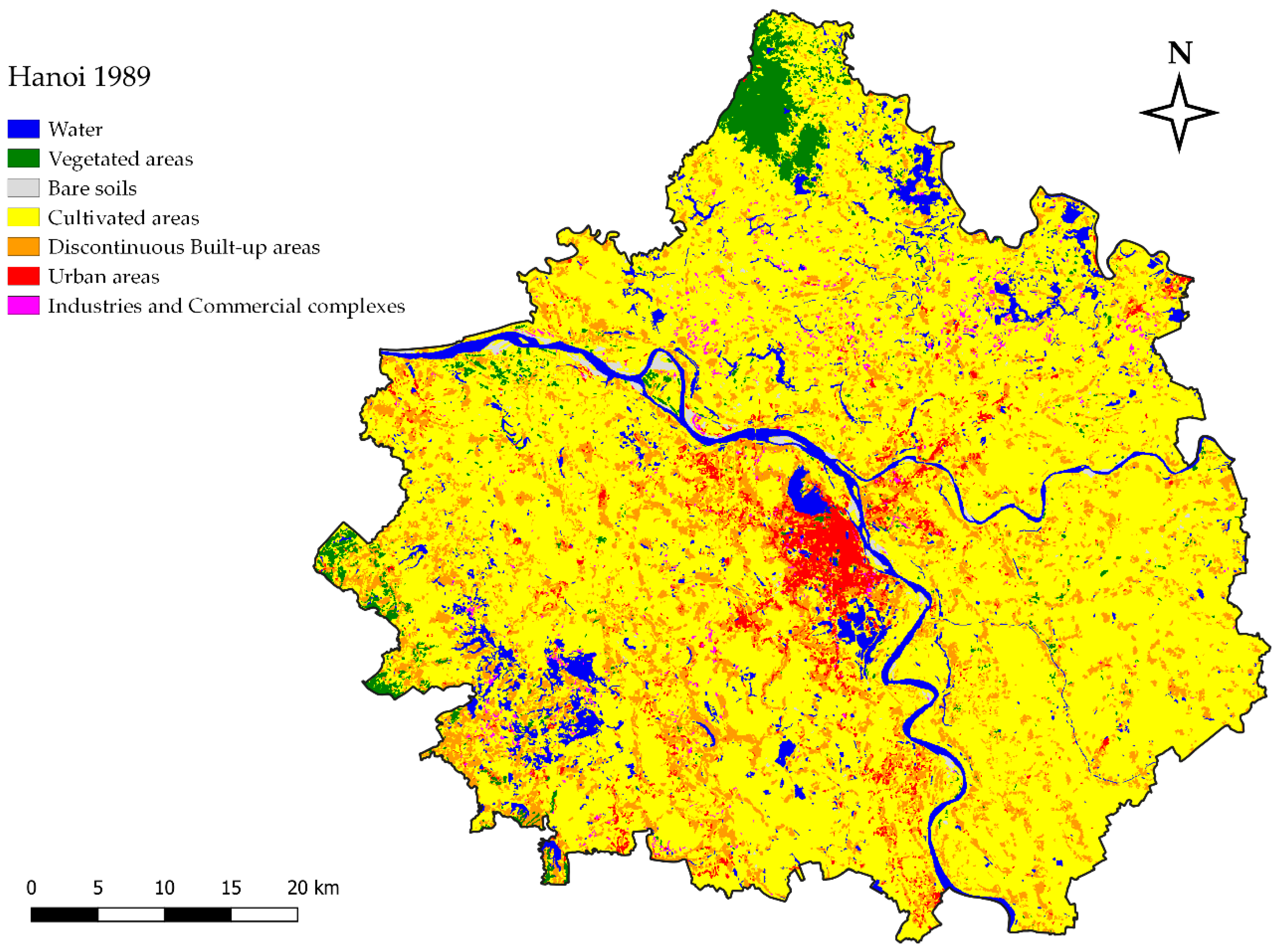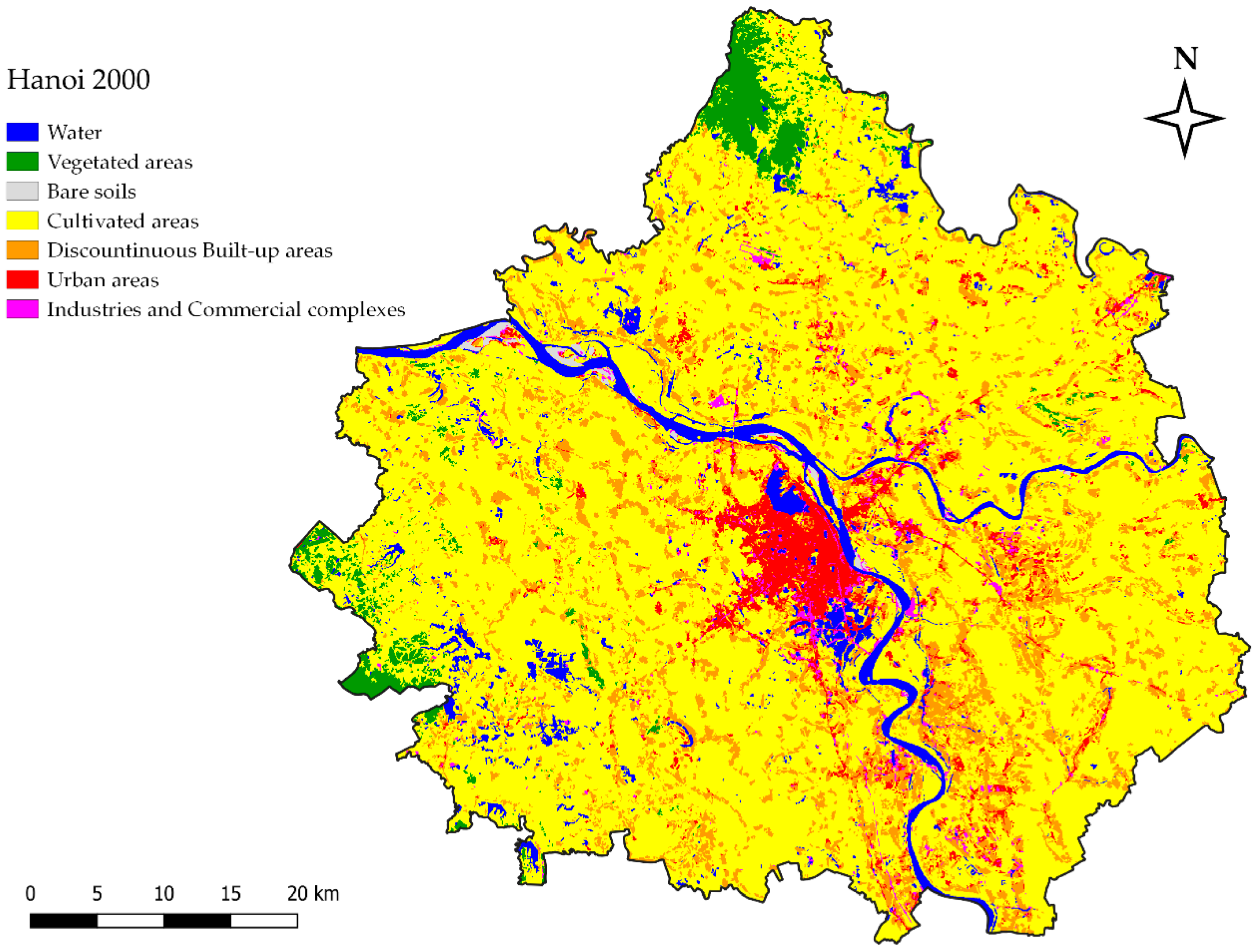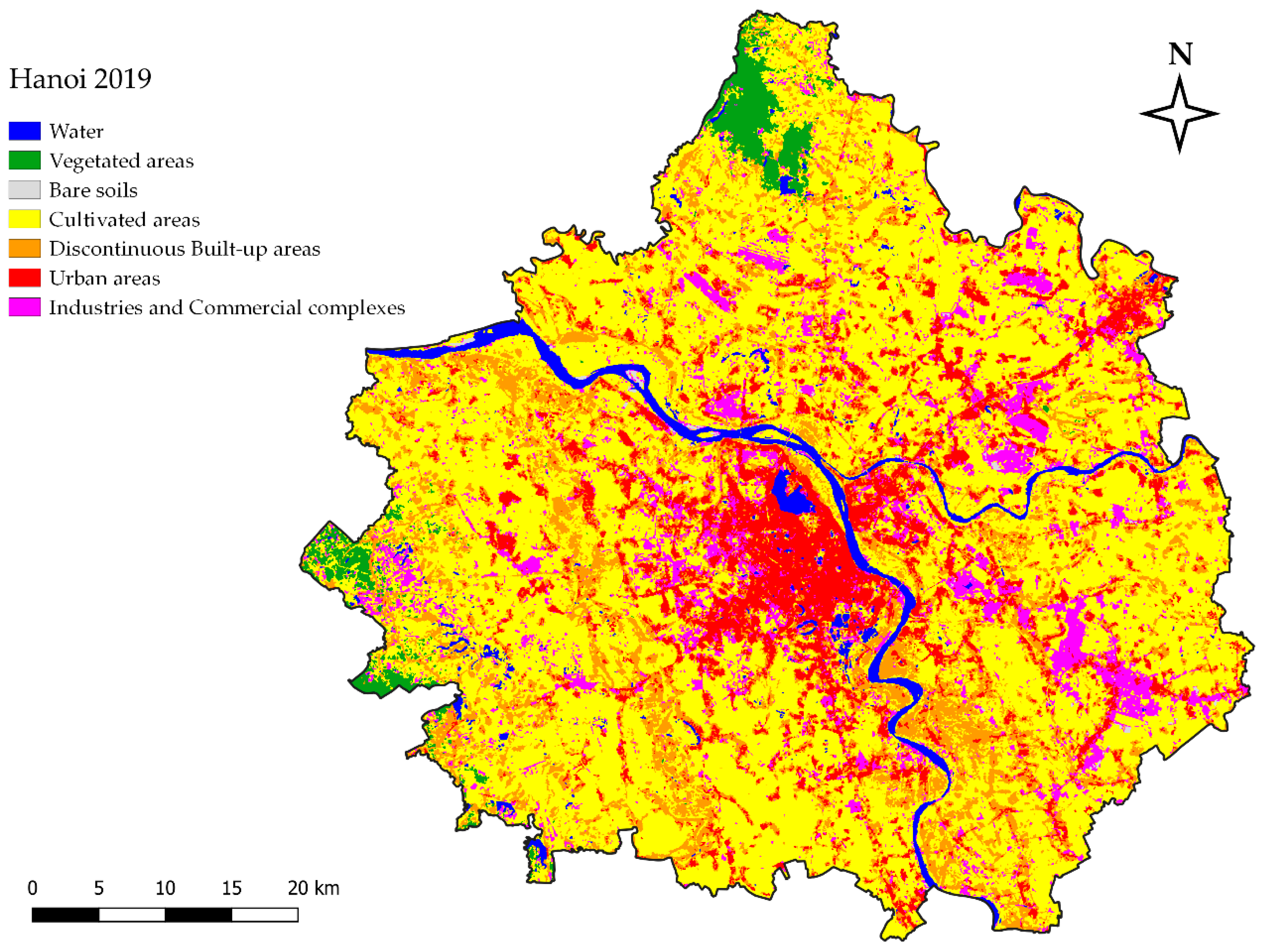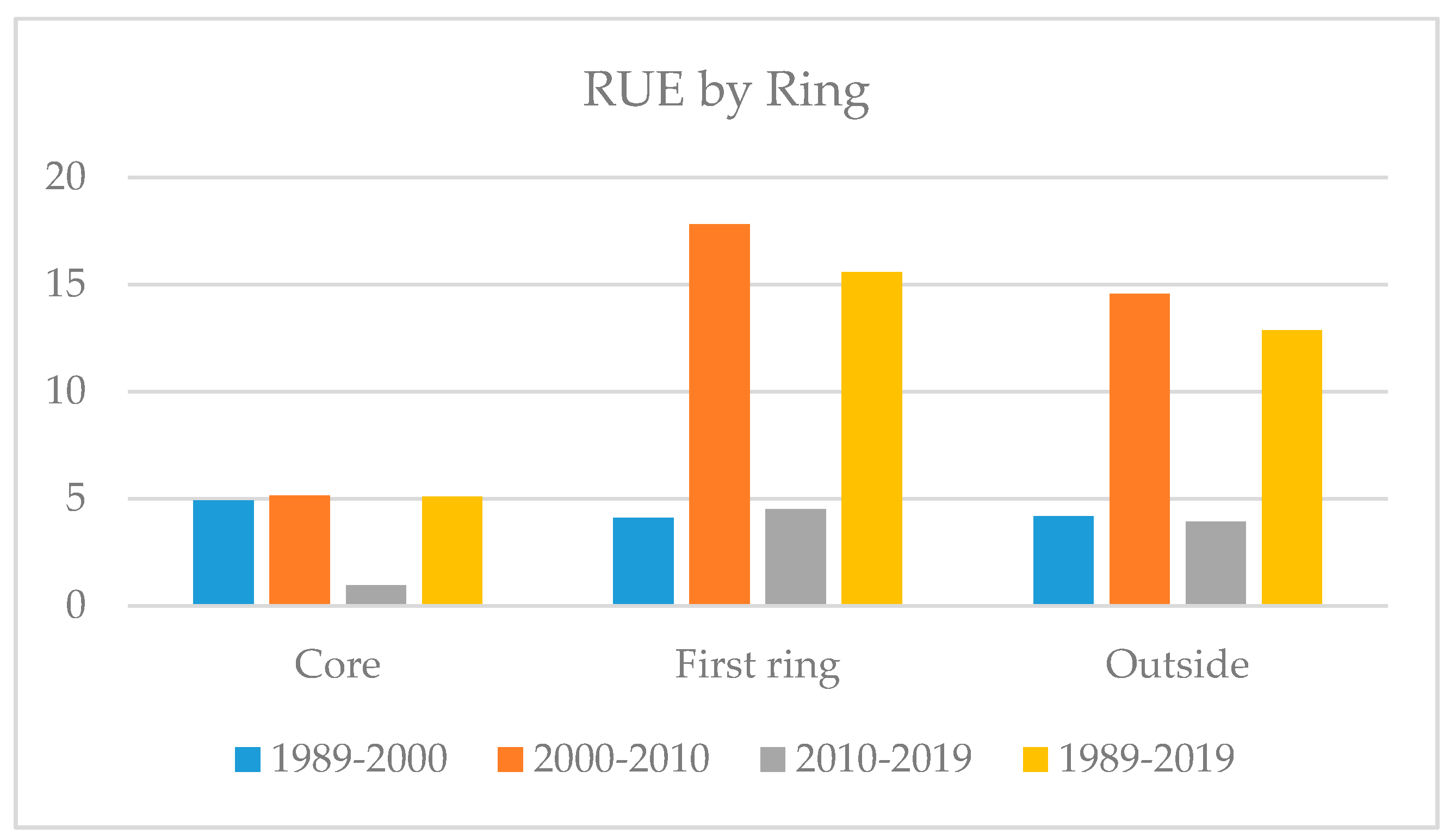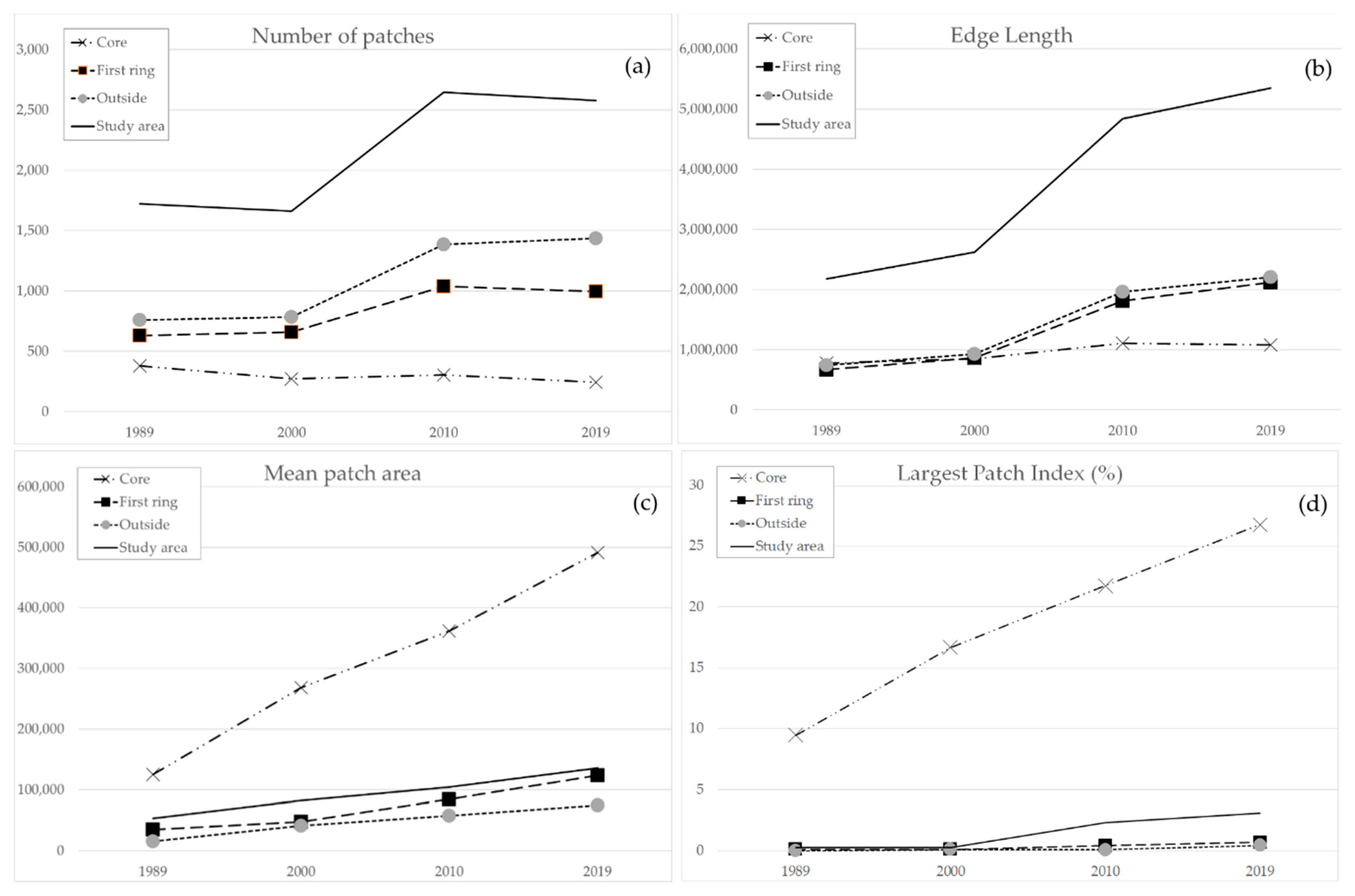1. Introduction
In the last few decades, the remarkable increase in the number of people living in urban areas around the world has posed new problems and created fresh challenges for urban planning and urban policies. More than four billion people (about 55% of the world’s population) are now living in cities and it is likely that all of these regions will be even more urbanized in the coming years [
1]. Even though, in 2014, close to one half of the world’s urban population was living in settlements with fewer than 500,000 inhabitants, the trends indicate that the number of medium-sized cities (of 1–5 million people) and large cities (of 5–10 million people) located in Africa and in Asia is growing rapidly, often by the expansion of slums [
2].
In 1990, there were ten cities in the world with more than 10 million inhabitants: in 2018, the number had tripled to 33, 19 of which are in Asia [
3], often through a combination of recent economic growth and high-speed rural–urban transition. One of the fastest urbanizing regions in the world is East and Southeast Asia, which has seen urban land expansion at unprecedented rates in towns with increasing density [
4].
Although it is still a predominantly rural country (agricultural and forestry land accounting for almost 80% of land use in 2019), the people living in urban areas of Vietnam account for about 35% of the population (about 96.5 million in 2019). In a bipolar territorial layout, the city dwellers are mostly concentrated in the country’s two main metropolitan regions: Hanoi (4 million) in the north and Ho Chi Minh City (7.2 million) in the south [
5]. In the last three decades, both of these cities have experienced rapid demographic growth, mainly due to the radical socioeconomic transformation taking place as a result of a program of economic reforms known as Doi Moi (‘renovation’), officially adopted in 1986. As shown by [
6], since the early 1990s, economic development has given rise to rapid urbanization, improving social conditions but often causing environmental degradation. In contrast to the collectivist period (1975–1986), characterized by an anti-urban policy [
7], cities are now regarded as the new key drivers of economic growth [
8]. Today, Hanoi and Ho Chi Minh City are the key regions of contemporary Vietnam, ensuring nearly 70% of the Gross Domestic Product (GDP) in the service and manufacturing sectors [
9].
Located to the north of the Red River delta region, Hanoi celebrated 1000 years of its troubled history in 2010. In view of the changes that have taken place in the Doi Moi period, several studies have explored the series of new challenges Hanoi is facing: the re-organization of its urban transportation system, i.e., [
10,
11]; the protection of its cultural heritage, i.e., [
10,
11,
12], whose importance has recently been recognized by UNESCO (since 2010, the World Heritage List has included the Central Sector of the Imperial Citadel of Thang Long); how to maintain and expand its economic role within Vietnam, mainly in comparison to Ho Chi Minh City, i.e., [
13,
14].
The rapid urbanization of Hanoi, which has taken place at an unprecedented pace over the last few decades, makes it a good example of a specific model of Asian urbanization, namely periurbanization. In rapidly developing Asian countries such as China and Vietnam, the fast urban growth in recent years has created what are called extended metropolitan regions [
15], namely urban areas usually surrounded by densely populated rural areas. As is well known, when a city grows, it spills out into the countryside. In North America, as in Western Europe, this phenomenon is referred to as urban sprawl. In Asian countries, the periurban areas are “where urban and rural processes meet, mix and interact” [
16] (p. 1147), “a zone of encounter, conflict and transformation surrounding large cities” [
17] (p. 426), where it is important “to distinguish between the near and the far periurban in relation to the central city” [
18] (p. 164). This Asian spatial model, named desakota (a term derived from the Indonesian words for village (des) and city (kota)) [
15], usually encompasses an area included between the inner core city and the outer zone (the “near periurban”). Here, the urban fringes grow very quickly beyond the limits of the city, often wiping out the pre-existing villages. Beyond this first zone, there is the “far periurban”, an area which is often very fragmented, and characterized locally by a high population density, small-holder agriculture (mainly rice crop) and a well-developed infrastructure of roads and canals. This area is very attractive for urban activities: the lower labor costs have encouraged industrial relocation in these well-connected rural areas, located near (but outside) the city where the environmental pressures (water and atmosphere pollution) and social issues (i.e., poverty and housing) now represent relevant problems. As well known, in the urban metabolism model, “a city can be defined as all the materials and commodities needed to sustain the city’s inhabitants at home, at work and at play” [
19] (p. 176). For these reasons, following this perspective (i.e., [
19,
20]), the periurban areas could be re-imagined as “non-city zones”, where “a range of metabolic byproducts (waste, pollution, carbon) are produced within and, eventually, absorbed back” [
21] (p. 25). If Hanoi city—with its very high density (more than 2400 persons/Km
2 [
5])—can represent the concept of concentrated urbanization well, its surroundings could be assimilated into operational landscapes: “non-city space transformed from capital forms of urbanization into zones of high-intensity, large-scale industrial infrastructure” [
22] (p. 125).
Today, the methodology of remote sensing is frequently used to map land cover or, from a diachronic perspective, the changes in land cover occurring in recent times at several different scales (local, regional, etc.). Since 2008, the United States Geological Survey (USGS) has made its Landsat archive freely available [
23]. This database of medium-scale satellite images covers more than 50 years and provides us with free, detailed and consistent geographical information; thus, interest in the use of Landsat imagery has grown continuously [
24], mainly since 2008. The fact that the acquisition of remote sensing data—Landsat and other satellite images—coincided with the rapid urbanization taking place in Asian countries made several studies possible regarding this topic, i.e., [
25]. Of course, Hanoi and Ho Chi Minh City (HCMC) are the two most investigated cities in Vietnam: many authors focused on their rapid growth and accompanying periurbanization. For example, [
26] used demographic and remote sensing data to study urban transition in Vietnam and classify municipalities as rural, periurban, urban or urban core. The temporal series from 1992 to 2010 of a low-spatial resolution satellite (a weather sensor mounted on the Defense Meteorological satellite) shed light upon the constant growth of urban areas and rural villages, but mainly upon the big increase in periurban areas over the same period [
27]. With regard to Hanoi, on the other hand, the studies made using remote sensing data are quite heterogeneous: for instance, they have used Landsat imagery to investigate the changes in the River Red section flowing though Hanoi [
28]; to trace the increasing impact of urban sprawl on the urban heat islands in the metropolitan area [
29], sometimes accompanied by a decrease in vegetation [
30]; to map the chlorophyll-a concentration in hypertrophic waters like those of West Lake in Hanoi [
31], etc. However, studies have usually turned their attention to the recent urban expansion of this city, also in comparison with other urban areas like Nagoya, Hartford and Shanghai [
32]. Until the beginning of this century, the spatial growth of Hanoi was partially limited by natural barriers such as streams, water bodies and swamp areas [
33,
34]. Combining spatial metrics with remote sensing data (Landsat and ASTER images) [
35] highlights how the expansion and outlying growth patterns prevailed between 1975 and 2001, while infill patterns were more important between 2001 and 2003. The rapid urbanization, which mostly occurred between 2001 and 2010, has also been highlighted by most studies, such as that of [
36]. They investigate the urban growth of Hanoi at the provincial level, using multi-temporal image stacks of Landsat Thematic Mapper ™ and Enhanced Thematic Mapper (ETM+) images (1993–2010 period) and population data from 1999 and 2009 as datasets. Their classification shows how the great urban expansion of the capital occurred mainly between 10 and 25 km from the city center. The greatest change was in the periurban and rural communities, as previously classified by [
26]. In these areas, there were significant demographic changes, such as an increase in population density in a 10 km radius around the city center. The dynamics of urban growth in Hanoi province have been closely examined by [
37]: they used a rural–urban gradient analysis to compare the metrics and other indexes of several spatial patches (estimated on the basis of the same database mentioned previously, period 1993–2010) and their results support the diffusion–coalescence theory of urbanization for Hanoi city.
As such, this paper too aims to detail and offer an update on the changes in land use/land cover (LULC) which have taken place in Hanoi and its surroundings in the aftermath of Doi Moi (1989–2019). The main purpose is not only to highlight the magnitude of the recent impressive growth of Hanoi, but also to reflect upon the relevance of remote sensing for urban planners in order to understand the dynamics and spatial patterns of urban expansion. For these reasons, the first step was to define the study area: this was not a single administrative district (such as a region or province), but consisted of all the administrative districts within a 30 km radius of the city center. The area is characterized by similar geographic conditions: it is a rural plain, well connected to the central urban area, surrounded by modest altitude reliefs to the north and northwest, crossed by a main river (the Red River), but rich in secondary waterways. In order to study the effects of urban growth, three hypothetical rings were identified: the core (within a 10 km radius), the first ring (between 10 and 20 km from the centre) and, finally, the outer zone (over 20 km from the centre). For this, we collected and classified four Landsat images, approximately every ten years (1989, 2000, 2010 and 2019). Working on a topographic scale (i.e., [
38]) in a Geographical Information System (GIS), it was possible to map—and understand—where the main changes in land cover have occurred in Hanoi during the last three decades. We then quantified the territorial development by decade and by ring to trace the progress of the periurbanization. Finally, using various different spatial indexes (the rate of urban expansion, some landscape metrics and the landscape expansion index), we examined the main landscape dynamics currently in progress. The paper is structured as follows: the study area, dataset and methodology are described in
Section 2 (Materials and Methods).
Section 3 presents and discusses our results, focusing on the classification of remote sensed data and on the dynamics of urban growth. In conclusion,
Section 4 contains some final remarks.
4. Conclusions
Remote sensing represents a great opportunity to monitor contemporary urbanization. In particular, the free Landsat imagery acquired since the 1980s makes it possible to investigate urban expansion in those regions currently experiencing the fastest rates of urbanization, namely East and Southeast Asia. In this study, multi-temporal Landsat images for the years 1989, 2000, 2010 and 2019 were used to produce LULC maps of Hanoi on a topographic scale, to understand the dynamics and spatial patterns of its urban growth. We considered all the districts within a radius of 30 km from the center. Over the last three decades (1989–2019), the urban fabric in the study area increased around fourfold (from about 90 km
2 to 350 km
2), with higher rates in the closest periurban suburbs than in the core. In the downtown districts, on the other hand, edge expansion and infill growth of urban patches were the most prevalent types of expansion the last thirty years; as well as an increase in LPI and MPA landscape metrics, these spatial patterns highlight the ongoing process of fusion between urban patches, mainly in the core of our study area. While the 1990s saw a gradual densification of the pre-existing urban area, the town has rapidly expanded outwards since the early 2000s, often spreading out radially along the axes of its main access roads, and ending up encompassing the neighboring rural villages. Confined for hundreds of years in a limited space on the right bank of the Red River, just like other newly globalized metropolitan areas, Hanoi is now a fringed city. It has spread with astonishing speed into the surrounding countryside, even bridging the geographical boundary of the river. In the current globalization era, in only few decades “city and countryside are redefined by the industrial logic of capitalist production and accumulation, losing much of their former substantive original traits” [
57] (p. 336).
At the same time, the region around Hanoi is no longer rural: in just thirty years, urbanization has converted this territory into an industrial and commercial region. New social and economic policies after Doi Moi in 1986 have given rise to rapid industrialization in the study area, with a huge loss of farmland on the fringes of Hanoi. In the period 1989–2019, we estimated a loss of almost 500 km
2 of agricultural landscape out of a total area of 3050 km
2 (meaning 16% less than 1989); moreover, the rural landscape is now less uniform and more fragmented than thirty years ago. In the meantime, industrial and commercial areas have grown steadily: while at the end of the last century, industrial parks were usually placed near the town, they are now often in the outermost periurban areas, frequently along the new main roads. Located far away from the city, the pre-existing small rural villages have grown in size and have often turned into “periurban craft villages” [
55] (p. 227): the traditional farming households have obtained a significant source of additional income from craft and semi-industrial activities. Concentrated mainly in the northern region of Vietnam, these craft villages have attracted up to 11 million people in recent decades [
58], resulting in significant levels of urban diffusion (as evidenced also by landscape metrics) and environmental pollution.
For accurate planning, it can be useful to also understand the dynamics and spatial patterns of urban expansion on a topographic scale, as provided by Landsat images. This is even more important if urban planners are unable to play an active role in shaping the development of the territory due to speculative interests on the part of stakeholders [
59]. The Hanoi Master Plan to 2030, implemented in 2011, highlights not only the opportunities, but also the challenges involved in bringing about sustainable development of these metropolitan areas [
14] (p. 77): for the time being, for example, the idea of creating a green corridor to the west of the urban core, “a green belt that protects productive farmlands, flood management areas, natural areas, craft and trade villages, and historic relics”, seems to have been shelved. By focusing on the recent changes occurring in Hanoi and its surroundings, our results have mapped out the current situation, while being fully aware of the compelling need for further research that can constantly monitor the future urban growth in this beautiful ancient city.
